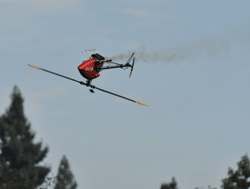Autonomous model ’copters learn to do expert tricks
Use of AI techniques lets aircraft learn from multiple imperfect examples and determine what top performance should be
An artificial intelligence system developed by computer scientists at Stanford University (www.cs.stanford.edu) lets robot model helicopters teach themselves to fly difficult stunts by “watching” other, human-controlled helicopters perform the same maneuvers. The self-taught autonomous aircraft can then perform a complete air show of complex tricks better and more consistently than an expert, without any human control.

An AI-controlled model helicopter designed by Stanford researchers performs complex stunts autonomously. (Photo: Eugene Fratkin, Stanford University)
Writing software for robotic helicopters is a daunting task, in part because the craft is an unstable system requiring constant input. Early on the researchers attempted unsuccessfully to write computer code that would specify the desired trajectory for a complex maneuvers. Simply replaying the exact finger movements of an expert pilot using a joy stick on a helicopter’s remote controller fails due to uncontrollable variables, such as gusting winds.
The researchers then had expert pilots fly air-show routines while recording every movement. The trajectory of the helicopter inevitably varied slightly with each flight, but the learning algorithms were able to discern the ideal trajectory the pilot was seeking.
During a flight, instrumentation on the ground and mounted on the helicopter continuously monitors the helicopter’s position, direction, orientation, velocity, acceleration, and spin in several dimensions. A ground-based computer crunches the data, makes quick calculations and beams new flight directions to the helicopter via radio every 50 ms.
With a larger helicopter, the entire instrumentation/ computer package could be airborne. Proposed uses for such autonomous helicopters include searching for land mines in war-torn areas, or locating wildfire hot spots in real time so firefighters can quickly move toward or away from them. For further information, contact Assistant Professor Andrew Y. Ng, 650-725-2593, ang@cs.stanford.edu, www.cs.stanford.edu/~ang.
Richard Comerford
Advertisement
Learn more about Stanford University





